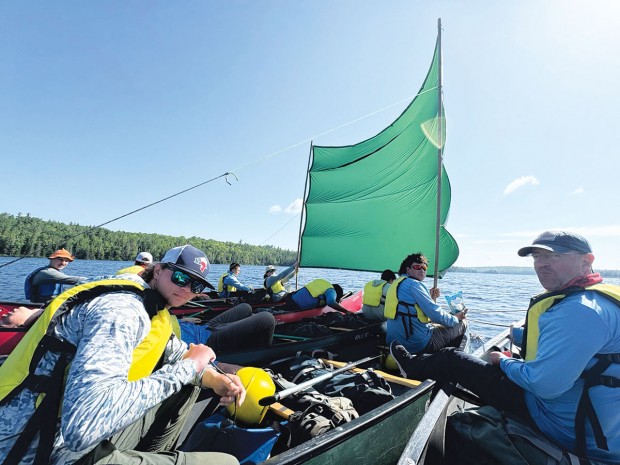When Boys Lead the Way
Houston Scouts Navigate Maine’s Allagash Waterway


HIGH ADVENTURE CREW Boy Scouts from Troop 599 completed a 50-mile backcountry canoe trek through Maine’s remote Allagash Waterway. Pictured, from left: Luca Paullo, Assistant Scoutmaster Adrian Binnion, Jonathan Lackey, Alden Binnion, Diego Vasquez, Dustin Oglesby, Wyatt Binnion, Wyatt Smejkal, Matthew Le, Zach Parks, Guide George Ellis, and Scoutmaster Don Paullo.
Wyatt Smejkal stood knee-deep in a Maine river, watching his canoe slowly fill with water. The 16-year-old Houston Christian High School junior had successfully navigated six rapids that June morning, but it was the calm stretch that caught him off guard. Reflecting on the experience a month later, he said that he and fellow Scout Alden Binnion “tipped over on a very easy part that we should not have tipped over on,” he recalled wryly.
For seven days, Wyatt served as crew leader for nine Boy Scouts from Troop 599 – paddling through Maine’s North Woods – a responsibility that meant waking exhausted teenagers at 5:30 a.m., assigning dishwashing duties to close friends, and keeping spirits up when mosquitoes bit through hammocks and rain soaked through tarps. It was a far cry from Memorial Drive United Methodist Church, where the troop has its weekly meetings. And unlike the precisely choreographed programs at national Scout camps that book 18 months in advance, this trek through the Allagash Wilderness Waterway put the boys firmly in charge of their own adventure.
It was a trip that tested the mettle of every boy on that trek, Wyatt said, and after an initial period of disorganization, every one of them rose to the challenge.
“I saw people be more willing to do stuff just because they knew that somebody had to do it,” Wyatt recalled. “And if they were assigned, usually no one complained. It was less and less (challenging) as we went on.”
That transformation from chaos to competence didn’t happen overnight. When the Houston crew first arrived at Maine High Adventure base – on the northeast corner of Baxter State Park, accessible only by pontoon boat to an island on Grand Lake Matagamon – they dove into a signature ritual. Instead of receiving a predetermined itinerary, the boys got to choose their own 50-mile route through three million acres of privately owned timberland.
“Other high adventure trips, you’ll go there knowing what kind of adventure you’re going to go on, where you’re going to go, what you’re going to do,” explained Dustin Oglesby, one of the older Scouts. “At Maine High Adventure, you get to go to a map room and choose whether or not you want to do whitewater rafting, sightseeing, or rump-bumping” – the latter being the term for floating through rapids without a boat, wearing a life jacket “like a diaper,” as Dustin described it.
The boys chose a route that would test every skill they’d learned: six days of paddling across wind-whipped lakes and through boulder-strewn rapids, nights of cooking over a campfire (gas stoves were considered “a last resort”), and a three-quarter-mile portage through fallen trees.
Scoutmaster Don Paullo had visited family in Maine’s mid-coast since boyhood and knew about this lesser-known base from his canoeing research – knowledge that proved invaluable when the troop needed a last-minute alternative to overbooked national camps. Now, watching his Scouts navigate the same northern wilderness he’d explored as a young visitor, he maintained a deliberate distance. “Boy Scout trips are intended to be boy-led,” he explains. “The adults are really there just to offer guidance and for safety.”
That first night showed their inexperience. According to Don, “The first day we arrived in camp, the boys were a little bit disorganized, and it took them a longer time to set up camp and prepare their food and get their water purified.”
The water purification routine – 45 minutes of iodine treatment – proved particularly challenging. “There wasn’t enough time to clean the water, so we didn’t have a lot of water at all times,” Wyatt explained.
Matthew Le spent one miserable night learning about Maine weather the hard way. “They said, there’s a 20 percent chance of rain tonight. And I didn’t want to sleep in the tent because, you know, outside it’s really pretty. But then it rained really bad that night.” He spent five hours using his air mattress as a rain cover, getting no sleep before their longest day of whitewater paddling.
By day three, something had shifted. Wyatt had developed a system: “I would assign people to start the fire, gather firewood, set up the rain cloth… and one person from each tent would go and set up their tent.” The cooking rotation settled around Dustin, Zachary Parks, Luca Paullo, and Jonathan Lackey – “because they were always the ones pretty good at it.”
The morning routine became precise, aided by the shocking reality of northern summer days. “The sun’s up by like 4:45 a.m.,” Don notes. “Part of why we got going early was the sun was up but also the winds pick up on the lakes. So you really want to be moving across the lakes in the morning when the water’s flat.”
Some mornings offered unexpected gifts. When prevailing winds aligned, the boys fashioned a sail from their dining fly – an 18-by-12-foot tarp – and held their canoes together. “I think it was a three- or four-mile lake and I think we did it in 45 minutes,” Don calculated. “If we were paddling, that would have probably been an hour and a half or two hours.”

SAILING, SCOUT STYLE With the right wind and a little creativity, Troop 599 transformed a simple dining fly into a makeshift sail for a breezy start to their whitewater day. Guide George Ellis rudders the improvised sailboat while Luca Paullo and Dustin Oglesby hold the dining fly poles and Jonathan Lackey and Assistant Scoutmaster Adrian Binnion hold the support lines.
The true test came on what they called their “12-hour day”: 14 miles that began with sailing, transitioned to seven sets of rapids, and ended with a brutal portage. They were already exhausted by the time they hit this three-quarter mile obstacle course, where they had to drag and carry the canoes, laden with packs on their backs, through a passage with fallen trees everywhere blocking their path.
For Wyatt, one of the biggest challenges came in exercising leadership when it came to the chores.
“I don’t really like assigning,” he reflected. “It was all my friends, and you’re trying to choose someone to do dishes or something not very favorable. And that wasn’t very fun, having to choose one of your friends to do something difficult.”
The physical challenges were matched by unexpected moments of wonder. “We saw a moose, and we got up pretty close to it,” Wyatt said. The boys saw “lots of moose, lots of bald eagles,” according to Don, who noted “some of the boys saw as many as five moose. Everybody saw at least one moose...probably saw a half dozen bald eagles.”
Perhaps most remarkably, the boys adapted quickly to life without phones. “I don’t think anyone really wanted to use their phone,” Matthew observed. “You’re busy all day. You don’t have time for your phone. And at night, you’re just too tired.”
The skills they practiced in Scouts took on new urgency. “Tying knots. You know, you’re supposed to learn them, but you never really get to practice them on almost a daily basis,” Matthew explained. But now, “it’s really easy to knot or sail, because you do it really fast.”
By the final morning, the evolution was complete. “By the end of the week, after they’d understood it and learned what to do, they were a lot quicker,” Don observed.
Back in Houston, as Wyatt prepares to serve as senior patrol leader for the troop’s upcoming school year, he carries lessons from those seven days in Maine. Asked what he’ll remember years from now, there are so many snapshots: running the whitewater rapids, turning their dining fly into a sail and skidding across the lake, watching a moose up close – and, of course, getting comfortable with taking on a leadership role.
For a group of teenagers used to Houston’s predictable heat, the North Woods offered something they couldn’t have anticipated: a fresh, cool, sometimes wet and cold embrace of a whole different kind of nature. As Wyatt put it, recalling the mountainous green landscape: “It felt like a movie to me, just looking at it.”
After the six-day canoe trip and one final night on the island base, the crew traded paddles for postcards with two days exploring Maine’s rugged Atlantic coast – fishing off the rocks and enjoying the obligatory lobster dinner.
The return trip added one last twist to the adventure: a missed connection meant an unplanned overnight at Chicago Midway. True to the Scout motto of “Be Prepared,” Scoutmaster Don’s son Luca had stashed a sleeping bag and pad in his carry-on. Assistant leader Adrian Binnion took things a step further, stringing up a hammock between two airport columns and settling in. Days later, Binnion did a double take when the TSA posted a photo of a similar airport hammock setup with the caption: “Not all heroes wear capes, some just find the right columns.” It wasn’t him – but clearly, great minds pack alike.
Tips from Our Travelers
By Don Paullo
Scoutmaster Don Paullo has been spending time in Maine for many years, and shares tips for visitors:
Don’t miss: Maine is much more than Acadia, Bar Harbor, and lobster. If you are really interested in connecting with Maine’s rich logging history or canoeing the historic waterways, take a couple of days to explore Baxter State Park or The North Woods. You might even see a moose.
Favorite restaurants: I like my lobster with a view, and my two favorite lobster shacks with epic scenery are Shaw’s Fish & Lobster Wharf in New Harbor and Five Islands Lobster Co. in Georgetown.
Packing: Don’t forget a sweatshirt; it’s cooler in the evening than you expect – and don’t forget a raincoat.
Don’t forget to bring: A travel fly rod. There are many brooks full of brook trout, and in the north, you can catch the elusive landlocked salmon.
Avoid: The larger coastal cities on days the cruise ships are in port.
Local favorite: Order the blueberry pie; it’s made with local berries. Also, the state is full of seasonal ice cream shops. Go try them.
Safety tip: Should you see a moose, take your pictures from a distance, particularly if it is a cow with a baby.
Visit: The Maine Maritime Museum in Bath, and the Maine State Aquarium in Boothbay Harbor. Also take the lobstering tour in Kennebunkport; you will learn a lot about these singular crustaceans, and from the water you can view Walker’s Point and see the summer home of the Bush family.
Unexpected hit: Visit Portsmouth, N.H. It’s a cute colonial town with cobblestone streets.
Want more buzz like this? Sign up for our Morning Buzz emails.
To leave a comment, please log in or create an account with The Buzz Magazines, Disqus, Facebook, or Twitter. Or you may post as a guest.


